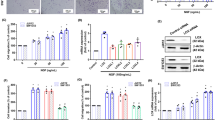Abstract
Proline rich polypeptide (PRP-1) produced by NPV and NSO cells is released into the general circulation and exerts its effect on the activity of immunocompetent and neuronal cells. PRP-1 is a unique regulator of hematopoiesis, stimulator of bone-marrow hematogenesis. Taking into consideration our preliminary data on antitumor and unique diverse biological properties of PRP-1 previously described by Galoyan et al., we proceeded with investigation of the PRP-1 effect on chondrosarcoma, the second most common malignancy in bone, which tends to be locally invasive and then metastatic. Currently it does not have any effective treatment and does not respond either to radiation or chemotherapy, leaving surgical resection as the only option. Our experimental results of PRP-1 action on human chondrosarcoma JJ012 cells demonstrated inactivation, abolishment of Myc oncogene activity usually upregulated in chondrosarcoma cells and other malignancies. The fact that addition of PRP-1 caused drastic inactivation of Myc–luc response element to the control level in human chondrosarcoma JJ012 cell line prompts to investigate further this neuropeptides powerful antioncogenic potential, opening up possibilities to consider PRP-1 as a potential therapeutic tool for chondrosarcoma treatment.








Similar content being viewed by others
References
Galoyan AA (2004) Brain neurosecretory cytokines: immune response and neuronal survival. Kluwer Academic/Plenum Publishers, NY
Galoyan AA (2008) The brain immune system: chemistry and biology of the signal molecules. In: Galoyan A, Besedovsky H (eds) Handbook of neurochemistry and molecular neurobiology, v.Neuroimmunology, Chap. 7, pp 155–195
Galoyan AA, Grigorian SL, Badalyan ChV (2006) Treatment and prophylaxis of anthrax by brain neurosecretory cytokines. Neurochem Res 31(6):795–803
Galoyan AA, Sarkissian JS, Chavushyan VA et al (2005) Neuroprotective action of hypothalamic peptide PRP-1 at various time survival following spinal cord hemisection. Neurochem Res 30(4):507–525
Galoyan AA (2000) Neurochemistry of brain neuroendocrine immune system: signal molecules. Neurochem Res 25(9/10):1343–1355
Galoyan AA, Aprikyan VS (2002) A new hypothalamic polypeptide is a regulator of myelopoiesis. Neurochem Res 27(4):305–312
Galoyan AA, Shirvanian AJu (2006) Patent N 1696 A
Simonyan GM, Nersesyan AK, Simonyan RM, Babayan MA, Simonyan MA, Galoyan AA (2005) Antitumor and antistressor effects of hypothalamic proline rich peptide (PRP-1) in sarcoma 45; possible biochemical mechanisms. Neurochemistry (RAS and NAS RA) 22(2):125–130
Galoyan AA, Shakhlamov VA, Kondakova LI, Altukhova VI, Polyakova GP (2001) The influence of proline-rich polypeptide on the morphology and mitotic activity of neurinoma Hassel node of tumor cells at rats (electron microscopic investigations). PNAS (Russian Academy of Sciences) 101(2):279–286
Galoyan AA, Shakhlamov VA, Malaytsev VV (2001) Changes in tumor cells L929 under PRP effect in vitro. Med Sci Armenia 41(1):25–29
Mirra J (1989) In: Lea and Febiger, bone tumors. Philadelphia
Frassica FJ, Unni KK, Beabout JW, Sim FH (1986) Dedifferentiated chondrosarcoma. A report of the clinicophathological features and treatment of seventy-eight cases. J Bone Joint Surg Am 68:1197–1205
Scully SP, Berend KR, Toth A, Qi WN, Qi Z, Block JA (2000) Marshall Urist Award. Interstitial collagenase gene expression correlates with in vitro invasion in human chondrosarcoma. Clin Orthop Relat Res 376:291–303
Galoian KA, Garamszegi N, Garamszegi SP, Scully SP (2007) Molecular mechanism of tenascin-C action on matrix metalloproteinase-1 invasive potential. Exp Biol Med 232(4):515–522
Fong YC, Yang WH, Hsu SF, Hsu HC, Tseng KF, Hsu CJ, Lee CY, Scully SP (2007) Methoxyestradiol induces apoptosis and cell cycle arrest in human chondrosarcoma cells. Orthop Res 25(8):1106–1114
Sherf BA (1996) Dual luciferase reporter assay: an advanced coreporter technology integrating firefly and renilla luciferase assays. Promega Notes 57:2–9
Schally AV, Cumaru-Schally AM, Nagy A, Kovacs M, Szepeshazi K, Plonowski A, Varga JL, Halmos (2001) Front Neuroendocrinol 22:248–291
Shachaf CM, Felsher DW (2005) Tumor dormancy and Myc inactivation: pushing cancer to the brink of Normalcy. Cancer Res 65:4471–4474
Bishop JM (1991) Molecular themes in oncogenesis. Cell 64:235–248
Druker BJ, Sawyers CL, Kantarjian H et al (2001) Activity of a specific inhibitor of the BCR-ABL tyrosine kinase in the blast crisis of chronic myeloid leukemia and acute lymphoblastic leukemia with the Philadelphia chromosome. N Engl J Med 344:1038–1042
Driker BJ, Talpaz M, Resta DJ et al (2001) Efficacy and safety of a specific inhibitor of the BCR-ABL tyrosine kinase in chronic myeloid leukemia. N Engl J Med 344:1031–1037
Felsher DW, Nicole Bradon (2003) Pharmacological Inactivation of MYC for the treatment of cancer. Drug News Perspect 16(6):370–374
Felsher DW (2003) Cancer revoked: oncogenes as therapeutic targets. Nat Rev Cancer 3:375–378
Author information
Authors and Affiliations
Corresponding author
Rights and permissions
About this article
Cite this article
Galoian, K., Scully, S. & Galoyan, A. Myc-oncogene Inactivating Effect by Proline Rich Polypeptide (PRP-1) in Chondrosarcoma JJ012 Cells. Neurochem Res 34, 379–385 (2009). https://doi.org/10.1007/s11064-008-9794-6
Received:
Accepted:
Published:
Issue Date:
DOI: https://doi.org/10.1007/s11064-008-9794-6




